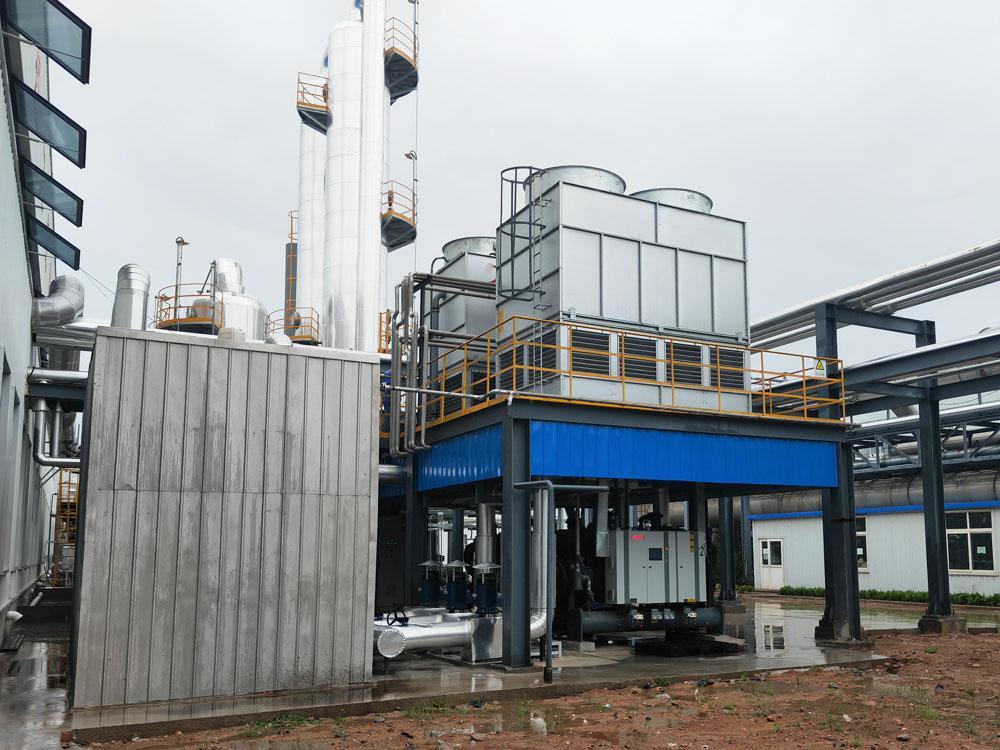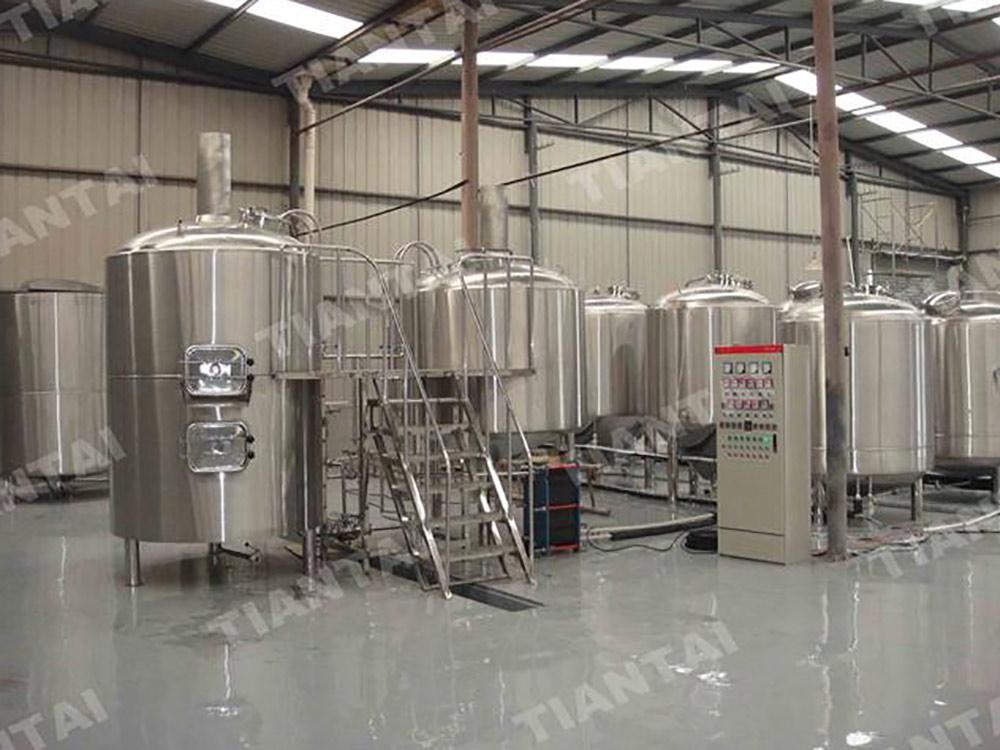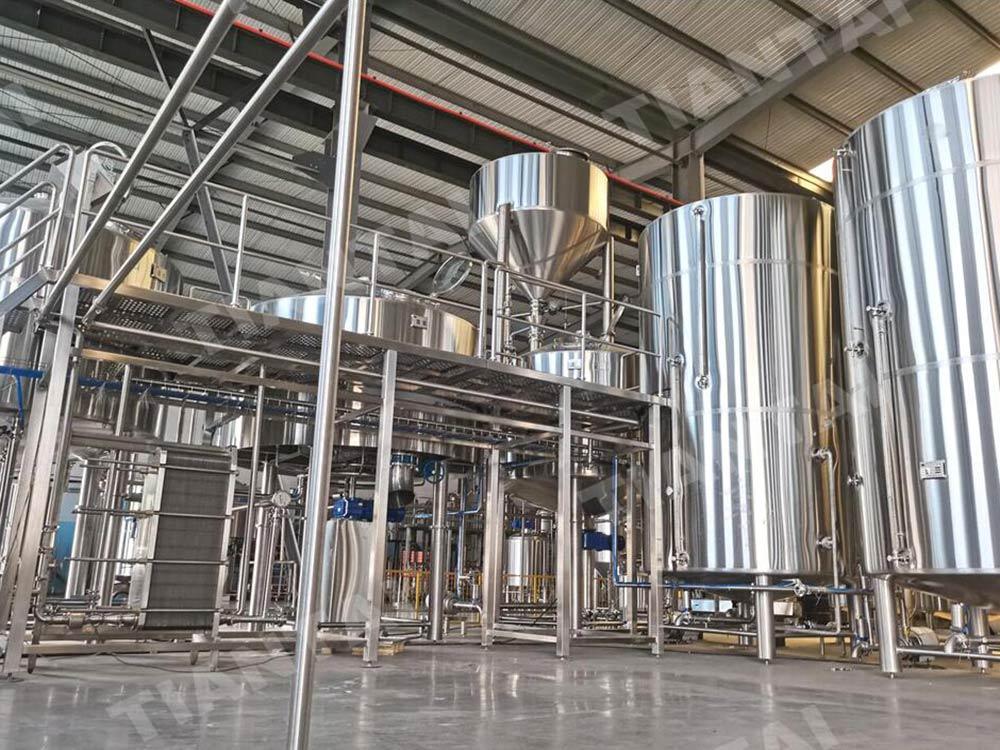Evaporative Cooling Chiller in Industrial Brewery
- Jun 06, 2025
- 168
- tiantai
Evaporative cooling chiller is widely used in industrial brewery and beverage sectors where reliable and efficient cooling is essential. Compared with common air-cooled or water-cooled chiller, evaporative cooling chiller offers significant energy savings and enhanced performance in hot and dry climates.
I. Working Principle
The evaporative cooling chiller combines mechanical refrigeration with evaporative cooling to reject heat more efficiently.
1. Refrigeration Cycle
A screw compressor compresses low-pressure refrigerant vapor into high-pressure vapor. This vapor flows through a condenser, where heat is rejected and the vapor condenses into a high-pressure liquid.
2. Evaporative Condensation
Unlike air-cooled systems that rely solely on ambient air, or water-cooled systems that use cooling towers, evaporative cooling chiller uses spray water and air simultaneously to cool the refrigerant in the condenser. Water is sprayed over condenser coils while a fan draws air through the falling water, causing rapid evaporation. The latent heat of evaporation effectively removes heat from the refrigerant.
3. Expansion and Evaporation
The high-pressure liquid refrigerant passes through an expansion valve, reducing its pressure and temperature before entering the evaporator. In the evaporator, the refrigerant absorbs heat from the process fluid (such as water or glycol), producing chilled water at the desired low temperature.
4. Return to Compressor
The refrigerant vapor returns to the compressor, and the cycle repeats.

II. Flow Diagram
Compressor → Evaporative Condenser → Expansion Valve → Evaporator → Compressor
III. Main Components
1. Screw Compressor: Efficient and reliable, suitable for continuous operation.
2. Evaporative Condenser: Combines water spraying and forced air to improve heat rejection.
3. Shell and Tube or Plate Evaporator: Transfers heat from the process fluid to the refrigerant.
4. Control System: PLC-based automation with temperature and pressure sensors.
5. Cooling Water Circulation Pump: Ensures continuous spraying in the condenser.
6. Water Treatment System (optional): Maintains water quality and prevents scaling.
IV. Advantages
1. Higher Energy Efficiency
Evaporative cooling uses the latent heat of water evaporation, which requires much less energy compared to conventional air-cooling. This results in 15–30% lower energy consumption, especially in dry climates.
2. Lower Condensing Temperature
By using both water and air to cool the refrigerant, the system achieves lower condensing temperatures than standard air-cooled chillers, improving overall COP (Coefficient of Performance).
3. Space Saving
Compared to cooling towers and water-cooled chillers, evaporative systems can be more compact and require less installation space.
4. Lower Water Consumption
Although water is used for spraying, the system consumes less water overall than traditional water-cooled chillers with large cooling towers.
5. Environmentally Friendly
Lower energy use means reduced greenhouse gas emissions, and newer models use eco-friendly refrigerants (like R134a, R507A, or R404A).
V. Applications
* Brewery and beverage plants (e.g., wort or fermentation cooling)
* Food processing and cold storage
* Pharmaceutical manufacturing
* Industrial process cooling
* Ice production and logistics centers
VI. Conclusion
Evaporative cooling chiller offers a balanced solution between energy efficiency, environmental responsibility, and reliable low-temperature performance. Their hybrid design makes them an ideal choice for industrial users seeking a sustainable and cost-effective cooling solution in challenging conditions.
If you need technical specifications or layout drawings of such a cooling chiller, feel free to ask!
I. Working Principle
The evaporative cooling chiller combines mechanical refrigeration with evaporative cooling to reject heat more efficiently.
1. Refrigeration Cycle
A screw compressor compresses low-pressure refrigerant vapor into high-pressure vapor. This vapor flows through a condenser, where heat is rejected and the vapor condenses into a high-pressure liquid.
2. Evaporative Condensation
Unlike air-cooled systems that rely solely on ambient air, or water-cooled systems that use cooling towers, evaporative cooling chiller uses spray water and air simultaneously to cool the refrigerant in the condenser. Water is sprayed over condenser coils while a fan draws air through the falling water, causing rapid evaporation. The latent heat of evaporation effectively removes heat from the refrigerant.
3. Expansion and Evaporation
The high-pressure liquid refrigerant passes through an expansion valve, reducing its pressure and temperature before entering the evaporator. In the evaporator, the refrigerant absorbs heat from the process fluid (such as water or glycol), producing chilled water at the desired low temperature.
4. Return to Compressor
The refrigerant vapor returns to the compressor, and the cycle repeats.

II. Flow Diagram
Compressor → Evaporative Condenser → Expansion Valve → Evaporator → Compressor
III. Main Components
1. Screw Compressor: Efficient and reliable, suitable for continuous operation.
2. Evaporative Condenser: Combines water spraying and forced air to improve heat rejection.
3. Shell and Tube or Plate Evaporator: Transfers heat from the process fluid to the refrigerant.
4. Control System: PLC-based automation with temperature and pressure sensors.
5. Cooling Water Circulation Pump: Ensures continuous spraying in the condenser.
6. Water Treatment System (optional): Maintains water quality and prevents scaling.
IV. Advantages
1. Higher Energy Efficiency
Evaporative cooling uses the latent heat of water evaporation, which requires much less energy compared to conventional air-cooling. This results in 15–30% lower energy consumption, especially in dry climates.
2. Lower Condensing Temperature
By using both water and air to cool the refrigerant, the system achieves lower condensing temperatures than standard air-cooled chillers, improving overall COP (Coefficient of Performance).
3. Space Saving
Compared to cooling towers and water-cooled chillers, evaporative systems can be more compact and require less installation space.
4. Lower Water Consumption
Although water is used for spraying, the system consumes less water overall than traditional water-cooled chillers with large cooling towers.
5. Environmentally Friendly
Lower energy use means reduced greenhouse gas emissions, and newer models use eco-friendly refrigerants (like R134a, R507A, or R404A).
V. Applications
* Brewery and beverage plants (e.g., wort or fermentation cooling)
* Food processing and cold storage
* Pharmaceutical manufacturing
* Industrial process cooling
* Ice production and logistics centers
VI. Conclusion
Evaporative cooling chiller offers a balanced solution between energy efficiency, environmental responsibility, and reliable low-temperature performance. Their hybrid design makes them an ideal choice for industrial users seeking a sustainable and cost-effective cooling solution in challenging conditions.
If you need technical specifications or layout drawings of such a cooling chiller, feel free to ask!



.jpg)
